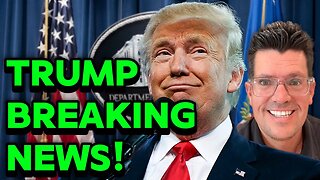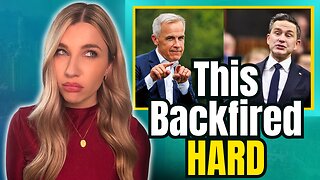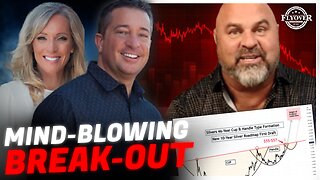Premium Only Content

The Cracks Are Showing | The Gold Standard 2422
https://www.midasgoldgroup.com/
Welcome to another episode of The Gold Standard with your host, Jennifer Horn, and her special guest, Ken Russo, SVP of the Midas Gold Group, discussing “The Cracks Are Showing.” As the national debt continues to climb, we’ll explore the implications for the economy, the dollar, and your investments. Ken helps us understand how we’ve come to this financial crossroads. It was a pivotal historical moment. Let’s go back to April 1971, when President Nixon made the fateful decision to take the US dollar off the gold standard.
The Nixon Shock: Severing the US dollar from gold
In April 1971, President Nixon decided to sever the US dollar from the gold standard to curb inflation, stabilize the dollar, and prevent a run on US gold reserves. By ending the dollar’s convertibility to gold, Nixon transitioned the US to a fiat currency system, where the value of money has no ties to physical commodities, merely the trust and confidence in the government. This decision reshaped the global economic landscape, increasing monetary policy flexibility and contributing to long-term inflation and currency devaluation. Today, we’re still feeling the effects of this pivotal moment in our history as we navigate economic instability and rising national debt, highlighting the ongoing debate about the role of gold in preserving financial stability.
The US Government’s Debt Issue: A Growing Concern
One of the biggest catalysts for concern in 2024 is the US Government’s staggering debt, which now exceeds $34 trillion. This incredible debt load is the annual deficit and the cumulative total of public debt, which steadily increases. The debt service—the amount of money spent every quarter to satisfy the interest payments on the debt—has crossed a monumental threshold of $1 trillion every three months. This figure will surely rise, signaling severe long-term implications.
The Spending Problem
Politicians continue to spend money the government doesn’t have, leading to unsustainable fiscal policies. Programs such as the 2017 Tax Cuts and Jobs Act and expansions in Medicare coverage have added trillions to the national debt. This persistent overspending and an ineffective tax system have put the country in a precarious financial situation.
Monetary Policy and the Fed’s Role
The Federal Reserve’s monetary policy of printing money to manage economic crises and stimulate growth has led to inflation and a devaluing dollar. This approach ignores the psychological impact on investors and global confidence, leading to higher bond yields and escalating debt service costs.
Cracks in the Economy
Significant cracks are showing despite assurances from politicians and mainstream media that the economy is on the upswing. Often cited as a barometer of economic health, a few dominant companies prop up the stock market. As Ken Russo points out, the stock market does not reflect the financial realities faced by everyday people. The bullish stock market is losing steam, and the underlying economic instability is becoming more apparent.
Interest Payments and the Cost of Debt
Interest payments on the national debt will likely surpass significant budgetary expenditures like defense spending and Medicare by 2024, signaling a looming financial crisis. Escalating debt service costs threaten the country’s financial health.
The Consequences
The growing national debt, unchecked spending, and ineffective monetary policies significantly threaten economic stability. As we move towards a cashless society, it’s crucial to address these issues head-on.
Commercial Real Estate Losses: A Severe Impact on Banks and Investors
The recent sale of Pacific Place Mall in Seattle, Washington, highlights the severe impact of commercial real estate losses on banks and investors. Valued at $271 million, the shopping center sold for just $67 million. Devaluing assets held by banks contributes to financial instability. As Ken Russo points out, commercial real estate losses like the Pacific Place Shopping Center reveal deeper economic cracks than we’re led to believe.
Gold Outperforms All Other Asset Markets
Gold has consistently outperformed other asset markets, proving its resilience and value as a haven. Traditionally considered the safest investment, government bonds have plummeted 45% since April 2020, contributing to the closure of several banks due to realized losses. The US debt-to-GDP ratio is approaching 130%, a critical threshold that signals potential currency or market bond crises. Over the past five years, gold has outperformed the US dollar by 45%, twenty-plus-year bonds by 57%, and the Dow Jones Industrial Average by 16%. Gold has been synonymous with wealth and stability for centuries, maintaining its value through economic turmoil and market volatility.
______________________________________________________________________________________________
Listen to The Gold Standard: https://www.midasgoldgroup.com/gold-standard-radio-show/
Gold IRA: https://www.midasgoldgroup.com/gold-ira/
Invest in Gold: https://www.midasgoldgroup.com/buy-gold/
Guide to Owning Bullion & Coins: https://www.midasgoldgroup.com/bullion-guide/
Read the latest precious metals news: https://www.midasgoldgroup.com/news/
-
 25:03
25:03
Midas Gold Group
1 year agoPrepare Yourself for an October 22 Surprise | The Gold Standard 2433
54 -
 1:15:59
1:15:59
vivafrei
3 hours agoKash interview - 27 Minutes of No Answers! Another Soft-on-Crime Catastrophe! Pedo Coach? & MORE
148K53 -
 1:21:29
1:21:29
Winston Marshall
2 hours agoThe Dangerous Fracturing on the American Right Over Israel
9.23K24 -
 58:20
58:20
Redacted News
1 hour ago"Agenda 2030: You Will Own NOTHING — Here’s What That Really Means"
28.4K36 -
 24:59
24:59
Stephen Gardner
2 hours agoBREAKING LEAK: Trump Prepping Huge White House Shake-Up!
20.9K31 -
 23:43
23:43
Jasmin Laine
2 hours agoLiberal Minister Demands ‘MAGA Apology’—MELTS DOWN Over ‘Trade War’
4K2 -
 LIVE
LIVE
LFA TV
19 hours agoLIVE & BREAKING NEWS! | TUESDAY 11/25/25
851 watching -
 LIVE
LIVE
freecastle
7 hours agoTAKE UP YOUR CROSS- Be devoted to one another in LOVE. Honor one another ABOVE yourselves!
134 watching -
 18:24
18:24
Neil McCoy-Ward
1 hour agoA Warning For European Citizens (THIS IS BAD!)
14.8K5 -
 1:29:42
1:29:42
The Quartering
4 hours agoTrumps Turkey Pardon Roast, Woke Pastor Destroyed, AI To Replace 40% Of Workers & More
110K13